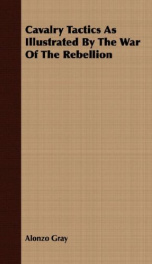cavalry tactics as illustrated by the war of the rebellion

PREFACE. In pursuing the subject of cavalry tactics I found that, while certain principles were accepted as correct, I was not familiar with the battles in which these principles were RP plied. 1 believe it to be true that there is no modern prin ciple of cavalry tactics, which is accepted today as correct by any first-class military power, which was not fully illustrated r during the War of the Rebellion. No war which has occu ed since that time has, in any respect, added to the cavalry tac tics which were in daily use during that great struggle. I give it as my humble opinion that increased range of firearms and the addition of machine guns, increase the sphere of action of, and necessity for, well-organized cavalry that bicycles, motorcycles and automobiles will prove to be only valuable auxiliaries to cavalry in transporting information back to the rear, and thus saving an unnecessary expen diture of horse flesh and that while flying machines may bring information, by so doing they will widen the sphere of action of good cavalry and, more than ever before, as a result of such information, it will be necessary to have good cavalry ready to move on extremely short notice. In looking for examples to illustrate the tactical prin ciples of cavalry operations, I have drawn mostly from the Records of the Rebellion indicated in refere ces b y R. R., but have not endeavored to give exact quotations instead I have quoted only so much as is necessary ta illustrate the point involved. The illustrations are taken mostly after the opening campaign of I 863, at which time the Federal cavalry reached an4 efficient condition. At this time the Confed erate cavalry was at its best. Life and campaigns of Maj. Genl. j. E. B. Stuart, p. 257. The reason why tnore Federal than Confederate reports are quoted is because the former are much more numerous. Whenever a report states what happens to the enemy or the enemys losses, be the report Federal or Confederate, that portion of it should be accepted with great caution. While the work principally treats of tactics, I have incorporated reports of such facts and expedients as are use ful for every cavalryman to know. It is my intention to follow this work, Part I, with a work on Troop Leading of Cavalry, wherein the decisions are based on the principles herein illustrated. This work is undertaken in the hope that the lessons learned during our great war will not be forgotten. Camp Stotse lburg, Parnpanga, P. I. March 3 1, 1910. INTRODUCTION. A dONCIIBE EEBTORY OF THE ORQANIZATIOS AND ARMAMENT OF THE UNITED STATE8 UAVALBY. The first mounted force, collsisti ig of one - quad-lIarch5,17m ron, n7as autl orized by Act of Congress Alarch 5, 1792. The Act of March 2, 1799. authorized three regi-March a . 1 7 to ments of cavalry, to be cornposed of five squadrons of . r. rchlc, lao2 two companies each. They were not all raised, and those which were raised clu-ere mustered out March 16, 1802. The Act of April 12, 1808, authorized a regiment , ipril 12,1803. of Iight dragoons. By Act of January 11, 1812, Coligress ordered an-. rannaryu, iale2 other regiment of light dragoons. By Act of March 30, 1814, these light dragoon 3l rch m , 1814. regiments 1 cre consolidatecI. The consolidated regiment was composed of eight troops, each colisisling of five officers alld 11 6 enlisted men. By Act of Congress, Jul e 13, 1815, this regiment . June 15,1815. was disbanded. Congress, by Act of Ilarch 2, 1833, authorized varch a . 1 the raising of the 1st Dragoons. This was the heglnl i n g of our present cavalry organization...
Info about the book
Author:
Series:
Unknown
ISBN:
0300084617
Rating:
3.5/5 (3)Your rating:
0/5
Languge:
English
Users who have this book
Users who want this book
What readers are saying
What do you think? Write your own comment on this book!
write a commentif you like cavalry tactics as illustrated by the war of the rebellion try:
Do you want to read a book that interests you? It’s EASY!
Create an account and send a request for reading to other users on the Webpage of the book!


